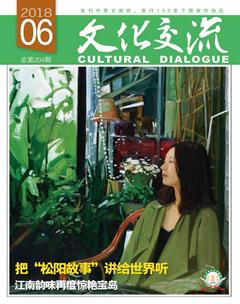讓傳統從容走向未來
郭藝
筆者2017年底赴德國國家瓷器博物館進行學術和業務交流。該博物館位于巴伐利亞州上弗蘭肯地區的小城市塞爾布,城市人口1.5萬,該市是德國現代瓷業中心,繁盛時期,德國80%的瓷器產自這里。
城市到處能尋覓到瓷器的蹤跡,瓷器街道,瓷器店鋪,瓷器噴水池,還有世界上唯一的瓷器圣誕樹。即便是厚厚的大雪,也掩蓋不了瓷城的特色,何況,這里還擁有歐洲最大的瓷器博物館。德國南部的冬日,偶爾陽光掠過,天空便出奇的燦爛,朵朵白云在藍天中疊加出層次豐富的色差。然而,冬季的太陽似乎很吝嗇,明媚的光影短暫出現后,隨即便復歸于陰沉的灰色之中。由于晝短夜長的緣故,早出晚歸的上班模式幾乎都在夜色里。
友情·你我他
博物館安排我住在城里的路易斯酒店,位于城市中心的酒店有百年歷史。酒店由一對夫婦經營,丈夫依格負責采購和烹飪,憨厚不善言談,女主人蘇西非常勤勞,酒店的所有事務都由她打理。早上6點就能在餐廳看到蘇西忙碌的身影,即便與我聊天,也是在不停地擦著餐具。夫婦倆淳樸善良,待我如親人一般。
我每天搭同事佩姬拉女士的車上下班,她是博物館藝術與文化史部的負責人,我在她的部門工作。平時大大咧咧的佩姬拉女士,工作起來干練高效,她爽朗的笑聲讓我難以忘懷。
館長西門先生是一位讓人尊敬的傳統的巴伐利亞人,印象深刻的是與他一起去柏林。塞爾布至柏林390公里,早上7點整,63歲的西門館長準時到酒店門口接上我。天上飄著大雪,地上厚厚的積雪,至柏林的一段高速因此關閉,車只得在一般公路上小心行駛。8點是博物館上班時間,館長開始通過車載電話與博物館人員商議工作。上午11點到柏林停好車,館長在寒風中換上正裝,進入西門子基金會辦公室。談好工作后,我們在KPM博物館附近的咖啡店點了面包和咖啡作為午餐,下午一起去KPM博物館參觀交流,下竿4點32分從KPM博物館出來直接駕車返程,回到塞爾布已是晚上8點20分了。
佩姬拉告訴我說,公務活動都是館長自己駕車的。我在他們身上,能感受到德國人的勤勞、嚴謹、敬業等優秀的品質。
風物·博物館
德國國家瓷器博物館由1866年的羅森塔爾公司廠房遺址改建,作為瓷器工業歷史遺址,有著重要的文化價值。1988年巴伐利亞州政府購買了這座廠房,每年提供80萬歐元作為歷史建筑物的維護費用。這座曾經的瓷器工廠,現作為工業文化遺產保留下來。1996年塞爾布館區正式向公眾開放,設有:歐洲瓷器工藝博物館,展示19世紀歐洲瓷器工業的輝煌,通過從業者社會生態及瓷器工業技術,展示了瓷器工業的發展;羅森塔博物館,讓觀眾置身于藝術創意的空間中,穿越時空融入到羅森塔的故事里;歐洲科技陶瓷博物館,展現了瓷器在高科技領域的應用。
某一行業的式微并不意味著其將在未來的發展中消失。作為某個歷史的坐標,無論是以怎樣的形態存在,其文化影響依然會在每個時代發揮作用,在歷史與當下的對照中,如果我們客觀審視社會變遷,會找尋到文化歸屬與認同。工業文化遺產不僅是歷史記憶,更是當下創新發展的重要資源,德國眾多的工業遺產博物館都在踐行這樣的理念,并以一百多年的文化遺產保護的實踐,證明對社會的貢獻。
教育·人文課
國家瓷器博物館與傳統意義上的博物館不同。建立在工業遺址上的博物館,除了本身承載的文化記憶之外,采用了諸如現場活態展示、瓷器制作的作坊、音像場景還原等方式,讓人們在動態的場景式環境中,感受瓷器工藝的精彩。
博物館設置的教育項目針對不同的受眾人群,如幼教、中小學教育、家庭體驗及成年人的休閑項目,當然,在博物館教育當中,中小學的教育占了很大的比重。博物館設有專業的教育項目與中小學的教育相銜接,包括參觀流程、教學互動、娛樂體驗等,都適應學校學科設置。學校根據自身教育的需要,預約相應的課程項目。配合中小學教育,博物館教育部提供簡單的知識性資料,另有一份專門為學校老師制定的知識材料,并附有征詢老師關于教育項目的建議表,幫助博物館改進教育內容。博物館的知識教育不是采用灌輸性的方式,而是把相應的知識與生活常識聯系起來,與學校的課程有機的結合,強調互動與體驗,鼓勵、啟發人們的創造潛力。
德國極其尊重傳統文化遺產,在保護文化傳統的同時,更重視對歷史的反思,對于傳統,不是一味的尊崇,而是以歷史的觀照,更理智地選擇走向未來的道路。因此,在所有的教育項目中,都能感受到傳統作用于當下的延續性,在歷史中尋求創新的動力,立足曾經的傳統,展望未來的發展。
文化·傳與承
德國邁森(Meissen)是歐洲瓷器發源地,其引以為傲的就是精湛的手工藝,300年來瓷器工廠堅守著這一傳統。
邁森瓷器工廠設有培訓學校,學校針對瓷器技藝傳承,制定了整套學習標準和專業課程,第一年學習繪畫基礎以及瓷器工藝,第二年開始進行瓷器手工藝的實踐,完成學業后,再進行兩年的實習。瓷廠工藝師負責帶徒傳藝,學員經兩年技藝實踐,成績合格者可留在邁森瓷廠,成為瓷廠的員工。邁森瓷廠的技藝人員都由本企業的學校培養,很多人在這里工作大半輩子,直至65歲退休。
進入邁森瓷器彩繪工作室,空氣里彌漫著瓷器顏料的氣息。每個工作室按照工藝的類別進行劃分,釉上彩工作室細分了各種不同門類的彩繪工藝;釉下彩工作室則是繪制青花,與中國一樣采用鈷料繪制。工藝家繪制的圖案技藝精湛,看得出經歷多年的實踐。從他們的年齡結構上看,老中青都有,傳統的技藝因幾代人的傳承煥發著勃勃生機。
企業帶徒傳藝的培養模式,為傳統技藝的延續提供了保障。職業人才培養是邁森瓷廠傳承了幾百年的歷史傳統,不僅傳承了工匠精神和核心技藝,也為企業提供了高質量的人才儲備,以精湛的手工藝保持了品牌的質量與榮譽,這便是邁森強大的競爭實力。
堅守傳統是邁森不變的追求,而這種堅持并不阻礙創新的意識。自歐洲瓷器在邁森發端起,研發一直伴隨著瓷器工藝的發展,從原料、工藝、顏料、釉料直到燒制,瓷器制作的每個環節均有高科技作為其質量的保證,由此,邁森瓷器燒制次品率極低,以保證人力和材料的高效運用。在這座具有歷史價值的老瓷廠里,傳統技藝與現代工藝和諧共融,呈現出歷史傳承給予的文化底蘊,以及融入當下的創新活力。
I spent a period of time at the German Porcelain Museum for academic study and exchanges toward the end of 2017. The museum is located in Selb, a small city with a population of 15,000. The city used to be the center of German porcelain manufacturing industry. In its prime time, it accounted for 80% of the porcelain products made in Germany.
The city is full of shapes, colors, charms of porcelain. Shops sell porcelain. Streets feature porcelain. Fountains feature porcelain. And the city boasts a porcelain Christmas tree, the only one of its kind in the world. The porcelain museum there is the biggest in Europe.
The city is in the south of Germany. It was winter. I saw sunny days only occasionally. When there was sunshine, the sky looked splendid with whitish clouds stacked upon each other showing a galaxy of rich colors against the azure sky. Such a sunny view was rare. When I was there, days were short and nights were long. I left for work when it was dark and I came back to hotel when it was dark.
I stayed at Louis Hotel, operated by Egon and Susi, a wife-husband team. Egon was in charge of buying and cooking. He was good natured and simple and largely reticent. Susi was almost omnipresent. At six in the morning she was in the restaurant. While chatting with me, she was busily working the tableware. They treated me as family.
Petra gave me a ride to work and back to the hotel every workday. She headed the art and cultural history department at the museum where I worked. She seemed to be casual in a lot of things off work, but was efficient and strict at her business. Her laughter is unforgettable.
The curator of the museum was Mr. Siemen, a respectable Bavarian of tradition. He drove me for 390 kilometers to visit KPM museum in Berlin. I was deeply impressed by the way he did his work. Later, I learned from Petra that the curator always chose to drive when it was on business. I was deeply impressed by the German peoples professionalism and diligence and attention to the smallest details.
The German Porcelain Museum is situated at the site of a factory founded in 1866 by the Rosenthal AG. In 1988, the Bavarian State government purchased the site and now provides 800,000 euro a year to maintain this building as an industrial heritage. In 1996, the Selb location opened to the general public. On the location are three museums: European Industrial Museum for Porcelain, Rosenthal Museum, and European Museum for Technical Ceramics.
The decline of an industry doesnt mean it will be pushed recklessly to oblivion in the future. The museums serve as historical coordinates and the bygone industrys cultural influence will play a positive role in different phases in a societys evolution. Culture provides a contrast and comparison between the past and the now, makes it possible to generate objective reviews of social changes, and seeks cultural identification and belonging. Industrial heritage is more than historical memory. It is a key resource for creativity now and in times to come. Germany boasts a large number of industrial museums which understand the role culture plays and have done their best to protect their cultural and industrial legacies as a contribution to the development of society.
The German Porcelain Museum differs a great deal from other museums in that it demonstrates how porcelain is manufactured. It operates myriad education programs targeting different groups of people: preschoolers, students of primary and middle schools, families, and adults. The museum coordinates with schools in constructive ways. Programs are designed in compliance with school curricula and schools can commission the museum to make tailor-made programs for students. The museum has an education department that provides teachers with information and solicits advice and suggestions from teachers.
During my stay in Germany, I also visited Meissen, where the first European porcelain was made in 1710. Over the past 300 years, the handmade art of the porcelain manufacturing has been maintained and improved at the town in eastern Germany. The training is the secret for the porcelain manufacturers enduring success.
There is a professional school where people learn how to make porcelain. A student spends the first year learning the basics of painting and porcelain manufacturing and spends the second year practicing. After the graduation the student works as a trainee for another two years under the tutelage of masters in the factory. As the two-year training expires, qualified students become employees of the factory. The technicians of the factory are all graduates from the school. Most employees work there all their lives until they retire at 65.
This training system guarantees a talent pool, quality, competitiveness, and innovation. The system is impressive.

